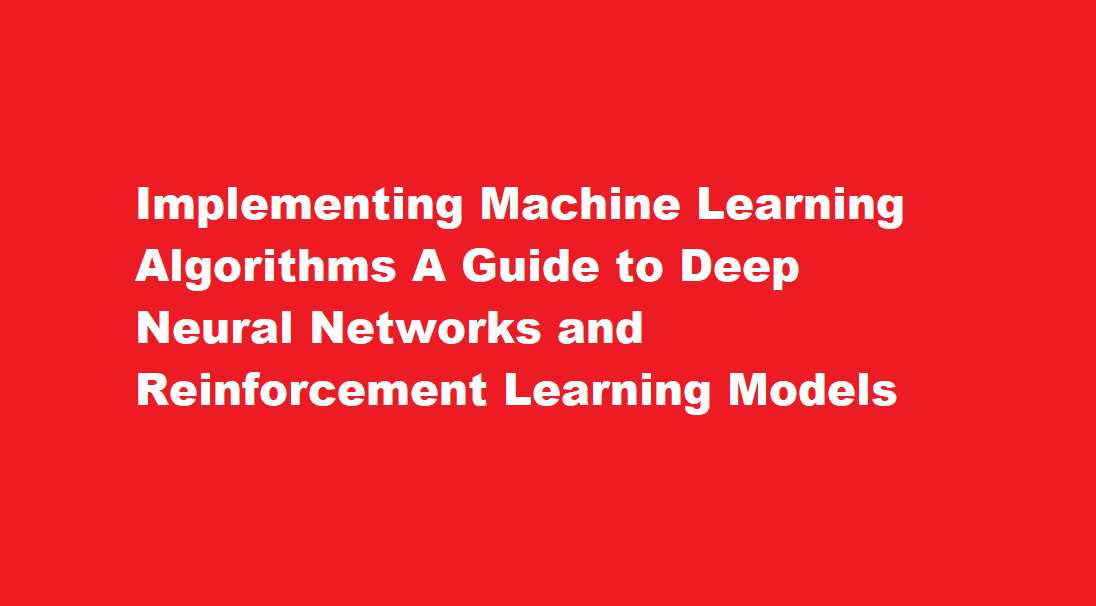Implementing Machine Learning Algorithms A Guide to Deep Neural Networks and Reinforcement Learning Models


Introduction
Machine learning has rapidly evolved into an essential tool in various industries, from healthcare and finance to autonomous vehicles and entertainment. Among the myriad of machine learning algorithms, deep neural networks and reinforcement learning models stand out for their remarkable capabilities. In this article, we will delve into the practical aspects of implementing these advanced algorithms, providing a step-by-step guide for newcomers and practitioners alike.
Deep Neural Networks (DNNs)
Deep Neural Networks (DNNs) have revolutionized the field of artificial intelligence by enabling computers to learn complex patterns from data. Here is a step-by-step approach to implementing DNNs
Data Collection and Preprocessing
Start by collecting high-quality data relevant to your problem. Ensure it is labeled correctly and is representative of the task.
Preprocess the data by cleaning, normalizing, and splitting it into training, validation, and test sets. Data quality significantly impacts model performance.
Choosing a Framework
Select a deep learning framework like TensorFlow, PyTorch, or Keras. These frameworks provide high-level APIs for building and training neural networks.
Architecture Design
Define the architecture of your neural network. Decide the number of layers, types of activation functions, and connectivity patterns.
Consider using pre-trained models (transfer learning) for tasks with limited data.
Model Training
Feed the training data into the neural network and use an appropriate loss function and optimization algorithm.
Monitor training progress by tracking metrics such as accuracy and loss on the validation set.
Apply techniques like dropout, batch normalization, and early stopping to prevent overfitting.
Hyperparameter Tuning
Experiment with different hyperparameters (learning rate, batch size, etc.) to fine-tune your model’s performance.
Utilize tools like grid search or Bayesian optimization to automate hyperparameter tuning.
Evaluation and Testing
Assess your model’s performance on the test set using evaluation metrics suitable for your specific problem (e.g., accuracy, F1-score, mean squared error).
Analyze the model’s errors to identify areas for improvement.
Deployment
Deploy your trained model in a production environment, ensuring compatibility with your target platform.
Monitor model performance in real-time and update it as needed to maintain accuracy.
Reinforcement Learning Models
Reinforcement learning is a subfield of machine learning focused on training agents to make decisions by interacting with an environment. Here’s how to implement reinforcement learning models:
Problem Formulation
Clearly define your reinforcement learning problem, including the state space, action space, and reward function.
Choose an appropriate reinforcement learning algorithm based on the nature of your problem (e.g., Q-learning, Deep Q-Networks, Policy Gradients).
Environment Setup
Implement the environment in which your agent will interact. This environment should adhere to the OpenAI Gym interface or similar standards.
Ensure the environment is properly documented, and its dynamics are well-understood.
Agent Design
Design the architecture of your reinforcement learning agent. This typically involves creating a neural network to approximate the value function or policy.
Initialize the agent’s parameters.
Training Loop
Implement the training loop, where the agent interacts with the environment, collects experiences, and updates its policy or value function.
Use exploration strategies like epsilon-greedy or softmax to balance exploration and exploitation.
Hyperparameter Tuning
Tune hyperparameters such as learning rate, discount factor (gamma), and exploration rate to optimize the agent’s performance.
Consider using experience replay and target networks for stability.
Evaluation
Evaluate the agent’s performance by running it in the environment for multiple episodes.
Measure performance using relevant metrics (e.g., cumulative reward, success rate).
Fine-Tuning and Experimentation
Iterate on your agent’s architecture and hyperparameters to improve its performance.
Experiment with different algorithms and techniques like prioritized experience replay or actor-critic models.
Deployment
If applicable, deploy your trained reinforcement learning agent in a real-world scenario, ensuring it behaves safely and effectively.
Continuously monitor and update the agent’s policy as needed.
FREQUENTLY ASKED QUESTIONS
What are the approaches used to implement reinforcement learning algorithms?
There are mainly three approaches to reinforcement learning: Value Based: Within the Value-based method, we try to maximize the value function V(s). In this approach method, the agent can dream of a long-term return at any state under policy (п) at any state.
What is the methodology of deep reinforcement learning?
Deep reinforcement learning methods use a “trial-and-error” approach to interact with the environment and improve its decision-making through continuous learning experiences as the intelligence interacts with the environment.
Conclusion
Implementing machine learning algorithms like deep neural networks and reinforcement learning models is a complex yet rewarding endeavor. This article has provided a comprehensive guide, covering the essential steps for building and deploying these advanced algorithms. Remember that practice and experimentation are key to mastering these techniques, and staying up-to-date with the latest developments in the field is crucial for success in the ever-evolving world of machine learning.
Read Also : Mastering Advanced Data Analysis and Statistical Modeling with Python and Libraries
Recent Posts
A Step-by-Step Guide to Turning Off Your PS4
Introduction The PlayStation 4 (PS4) has been a gaming staple for millions of gamers worldwide…
How to Get a Receipt from Amazon – A Step-By-Step Guide
Amazon, the world's largest online retailer, offers a convenient and efficient way to shop for…
How to Leave a Group Chat on iPhone – A Step-by-Step Guide
Introduction Group chats are a fantastic way to stay connected with friends, family, or colleagues,…
A Comprehensive Guide on How to Pack a Bowl
Introduction Packing a bowl is a skill that many individuals enjoy mastering, whether for medicinal…
How to Properly Turn Off a Tesla Electric Vehicle
Introduction Tesla electric vehicles (EVs) have revolutionised the automotive industry with their cutting-edge technology and…
The Art of Capturing Majesty – A Step-by-Step Guide on How to Draw an Elephant
Introduction Drawing is a beautiful form of expression that allows us to capture the essence…


